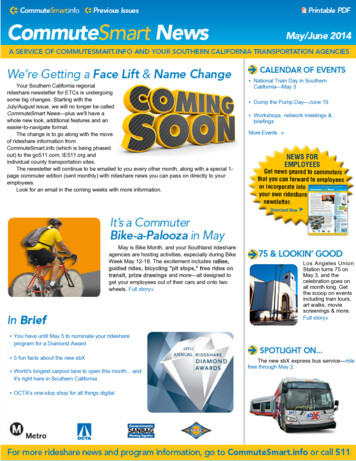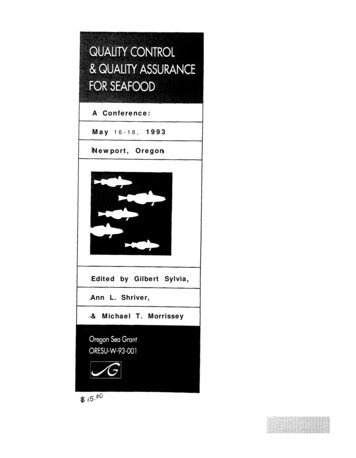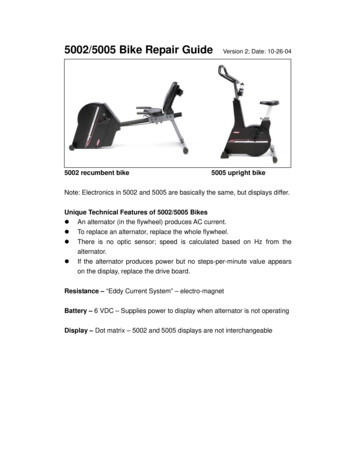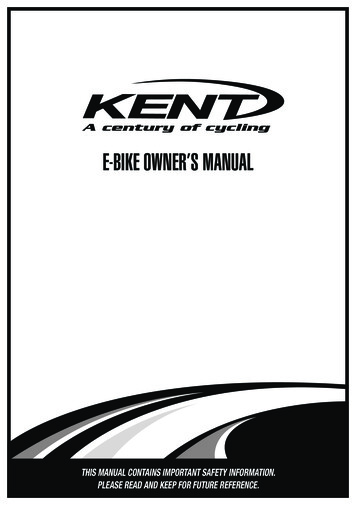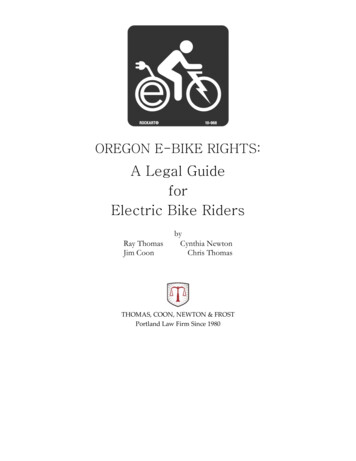
Transcription
OREGON E-BIKE RIGHTS:A Legal GuideforElectric Bike RidersRay ThomasJim CoonbyCynthia NewtonChris ThomasTHOMAS, COON, NEWTON & FROSTPortland Law Firm Since 1980
Cover image property of Rockart, Logo 10‐968Used with permission. Thank you, Rockart!https://www.rockartsigns.com/d72/
1PREFACEThis booklet about Oregon electric bicycle law is thefourth in our series of Oregon law guides. The first, “Pedal Power:A Legal Guide For Oregon Bicyclists” was published in 2000 and isnow in its eighth edition. That book has been widely distributed toriders, libraries, law enforcement, lawyers and has provided thetextbook for the regular “Bicycle Rights Legal Clinics” conductedstatewide by the lawyers in our office.It was our intention that “Pedal Power” serve as a law andadvocacy reference to help build Oregon's bicycle movement andadvance knowledge of Oregon law for cyclists, pedestrians andmotorists. Six years later in 2006 we produced “Action Pamphlet#1, A Do It Yourself Guide to Ticketing Bad Drivers, CitizenInitiation of Violation Proceedings” to provide a how-to guide totraffic court enforcement actions by private citizens. Then in 2008our walking rights legal guide “Oregon Pedestrian Rights: A LegalGuide For Persons On Foot” was published. It contained Oregonlaws as well as historic and legal analysis of the politics of thepedestrian right to a legal presence on the public way. It is beingrevised and re-issued in 2018 as a second edition.Now we are pleased to issue “Oregon E-Bike Rights: ALegal Guide for Electric Bike Riders.” “E-bikes” are appearing onOregon roads, paths and sidewalks in greater numbers, and federal,state and local authorities are of several minds about what to dowith them. Sometimes treated by law as a bicycle, sometimes as amotor vehicle, the bicycle with a battery powered electric motorhas created a legal hybrid that defies easy and logical categorization.The Oregon Vehicle Code defines a low-powered “electric assistedbicycle” to be a bicycle, not a motor vehicle, but then also prohibitsit from being lawfully ridden on sidewalks statewide. Oregon StateParks rules define the electric powered bicycle as a motor vehicleand restrict its operation to motor vehicle routes.E-bike law in Oregon and elsewhere is very much amoving target. Efforts to amend state and federal laws toreclassify electric bicycles and allow wider access are presentlyunderway, with several campaigns pending at this time. We
2support many of these efforts to reform state and federal park rulesto allow e-bikes broader access to trails and beaches. For manyriders an electric bicycle creates opportunities to travel places thatwould be unreachable on a regular bicycle because of advancingage, injury or other physical limitations. The battery operatedelectric motor provides these opportunities without the power,noise, erosion and pollution associated with gasoline-poweredengines. It is time for the laws to create a more hospitable legalenvironment for electric bicycle operators and coordinate the useof legal terminology and rules at the local, state and federal level toreduce presently existing confusion about where e-bikes can andcannot legally go.This book was truly a team effort. Cynthia Newton, ChrisThomas, Jim Coon and Ray Thomas all participated in the researchand writing, and we thank Janet Towle for helping us with thelayout and legal resources sections.
3I.WHO RIDES E-BIKES?Short answer – folks in China. The vast majority of e-bikes on theplanet are sold domestically in China – over 31 million in 2016, ascompared with just 3.3 million sold in the rest of the worldaltogether. Market saturation and restrictions on use in majorChinese cities are expected to flatten China’s e-bike growth whilethe rest of the world’s purchases increase, but China is stillprojected to sell five times as many e-bikes to its citizens (about 30million) as the rest of the world does (about six million) by 2025.1E-bikes are 27% of the total Dutch bicycle market, 16% inGermany, 7% in Japan and barely 1% in the U.S., where e-bikesales tend to rise with gas prices. Nevertheless, with an agingpopulation and improved battery technology, American e-bikemarket share is projected to continue growing. This is doubtlesstrue in Oregon, as graying Boomer cyclists reluctantly admit theycould use a little help.“Electric Bicycles,” Navigant Research (Q2 2016) accessed June 4, 2018at pdf1
4II.WHAT IS AN E-BIKE UNDER THE LAW?A.The Oregon Vehicle CodeOregon law defines an “electric assisted bicycle” as avehicledesigned to run on the groundon no more than three wheelswith fully operational pedals for humanpropulsionwith a seat for the riderwith an electric motor thato has power output no more than 1,000wattso can propel the vehicle no faster than20mph on level groundORS 801.258. The law has been around since 1997, but noappellate court has had occasion to say what it means. Running“on the ground?” No problem. On three wheels or fewer? That’spretty clear. With a seat and pedals for human propulsion? So farit’s just a bicycle. ORS 801.150. But of course the electric motoris the interesting part.1.A Thousand WattsAlso known as a kilowatt, a thousand watts is a little morethan one horsepower, about the power output of a microwaveoven or a toaster, or the power the sun delivers to a square meterof earth on a nice day. Of course there’s not much you can doabout it other than read what it says on the bike and trust themanufacturer to tell you how many watts the motor can generate.2.20 MPH on Level GroundThe law doesn’t say whether the 20 mph limit is with a 98lb jockey or a 300-lb offensive tackle on the seat. If speed islimited by an electronic governor rather than by the power of the
5motor, it should make no difference how big the rider is. Thecontroller cuts the power when the bike reaches 20 mph.And do we count the added human power? What if thebike will do 20 mph under electric power alone but goes 30 mphwhen the rider pedals hard with the throttle full open? TheOregon statute says the motor must be “incapable of propelling thevehicle” faster than 20 mph. That suggests that your e-bike can goas fast as you can make it go, as long as the motor alone will doonly 20 on a level surface. As a practical matter, with the motorcutting out at 20mph, you’re not likely to go a whole lot faster thanthat unless you’re headed downhill. Of course violating the speedlimit is a separate question; here we’re just talking about whetheryour bike qualifies for treatment as an e-bike under Oregon law.NOTE: The Oregon definition calls this an “electricassisted bicycle,” which suggests, in e-bike parlance, that it’s apedelec1. However, the definition itself doesn’t say it can’t be a“throttle-controlled” e-bike2, as long as it won’t go faster than 20mph and has a 1000 watt motor or smaller. Oregon courts readstatutes literally when they can, so it’s likely that either a pedelec ora throttle bike can be an “e-bike” under Oregon law.B.The Federal “Low Speed Electric Bicycle”State law controls most aspects of vehicle licensing andoperation. But federal law adds safety requirements for motorvehicles as consumer products and limits use of powered vehicleson federal lands. The Consumer Product Safety Act defines “lowspeed electric bicycle” asa two- or three-wheeled vehicle with fully operable pedalsand an electric motor of less than 750 watts (1 h.p.), whosemaximum speed on a paved level surface, when powered2 ‘Pedelec’ is an e-bike that applies power from the electric motor onlywhen the rider pedals.3 ‘Throttle-controlled’ means the motor delivers power when the rideroperates a throttle lever or other control, whether the rider pedals or not.
6solely by such a motor while ridden by an operator whoweighs 170 pounds, is less than 20 mph.15 USC 2085(b). Most e-bikes you’ll see for sale in bike shops willmeet these requirements. Again, as with the Oregon definition,this could be a pedelec or a throttle-controlled e-bike, and thequestion is whether the motor alone will make the bike go morethan 20 mph on a level surface.C.Other Motor Bikes: What Is NOT an E-bikeUnder Oregon Law?Electric two-wheelers (and three-wheelers) with morepower than the definition of “electric assisted bicycle” allows (morepower than 1000 watts or faster than 20 mph) are not e-bikesunder Oregon law. They include:A motor assisted scooter has a motor that will make it goup to 24 mph on a level surface, with up to 1000 watts if the motoris electric and displacement up to 35 cc if it’s a gasoline engine.ORS 801.348.A moped is a vehicle “other than an electric assistedbicycle” that has a motor that will make it go up to 30 mph on alevel surface and, if it’s a gasoline engine, is no larger than 50cc,with no gear shifting. ORS 801.345. This creates a technical legalproblem (see the definition of “motorcycle” below),A motorcycle is defined as any self-propelled two orthree-wheeled vehicle with a seat or saddle, “other than a moped orfarm tractor”:“Motorcycle” means any self-propelled vehicle other than amoped or farm tractor that:(1) Has a seat or saddle for use of the rider;(2) Is designed to be operated on the ground uponwheels; and
7(3) Is designed to travel with not more than threewheels in contact with the ground.ORS 801.365. 2D.What difference does the legal definitionmake?The point of having an e-bike that’s within the definitionof “electric assisted bicycle” is to be treated legally as a bicycle andnot as a motor vehicle, thus avoiding DMV registration, licensing,insurance, and other requirements that apply only to motorvehicles.When the Oregon Legislature first defined “electricassisted bicycle” in 1997, they also provided that an e-bike “shallbe considered a bicycle rather than a motor vehicle” under thelaw. ORS 814.405. Of course Oregon law also provides that abicycle “is a vehicle” under the vehicle code, with certainexceptions:(1) Every person riding a bicycle upon a public way is subject to theprovisions applicable to and has the same rights and duties as thedriver of any other vehicle concerning operating on highways,vehicle equipment and abandoned vehicles, except:(a) Those provisions which by their very naturecan have no application.(b) When otherwise specifically provided underthe vehicle code.Since a “motorcycle” is any self-propelled two-wheeler other than amoped, and a moped is defined not to include e-bikes, technically, e-bikesmight be considered to be within the Oregon definition of “motorcycles,”which would mean licensing, registration and helmets. In the unlikelyevent that Oregon tried to impose these requirements on e-bikes, thecourts would probably hold that e-bikes, or at least pedelecs, aren't wholly“self-propelled” because they're designed to be pedaled by the rider.4
8(2) Subject to the provisions of subsection (1) of thissection:(a) A bicycle is a vehicle for purposes of the vehiclecode; and(b) When the term “vehicle” is used the term shallbe deemed to be applicable to bicycles.ORS 814.400 (emphasis added). So, on one hand, a 20-mph, 1000watt e-bike is a bicycle, and, on the other hand, bicycles have thesame rights and duties as any other vehicle unless the vehicle codespecifically provides otherwise or unless “by their very nature,” thelaws can’t apply to e-bikes (DEQ emissions testing, or the lawagainst driving a motor vehicle in a bike lane, for example).E.When is a bicycle (including an e-bike) a“motor vehicle?”The Oregon Court of Appeals has considered the meaningof the “bicycle is a vehicle” statute only once, and its decisioncreates considerable uncertainty about when a bicycle, andtherefore an e-bike, is or is not covered by the laws that apply to“motor vehicles.” The court held in State v. Potter, 185 Or. App. 81(2002) that when a statute refers specifically to “motor vehicles,” itstill covers bicycles because the legislature has not “specificallyprovided” that bicycles are not covered,3 even though a “bicycle” isdefined in the law as a vehicle “propelled exclusively by humanpower.” So the only motor vehicle laws that don't apply to bikes,including e-bikes, are those that “by their nature cannot apply” (like5 The Potter court applied the statute prohibiting “impeding traffic,” ORS811.130, to bicycles although it prohibits driving a “motor vehicle” so asto impede traffic. The court reasoned that the impeding traffic statutedoes not “specifically provide” that bicycles are not covered. That’sespecially interesting because there is a statute that specifically coverswhen bicycles must ride as far to the right as they can and when they mayride in the traffic lane. See section III – “E-bike Rights on the Roadway.”
9tailpipe emissions and equipment standards) or where the statuteactually says “bicycles are exempt” (for example ORS 803.030(7)(title requirements) or ORS 811.405(2) (turn signals), or where thestatute gives bicycles specific rights and responsibilities, like theright and the responsibility to be in a bike lane.E-bikes will be subject to the same judicial analysis. If astatute says it applies to “motor vehicles,” and it doesn’t specificallysay bicycles are excluded, e-bikes, like regular bikes, will becovered.
10III.E-BIKE RIGHTS ON THE ROADWAYA.“Rider’s Bill of Rights”What rights does an e-bike rider have on the roadway? Theanswer is “The same rights as a regular bicycle operator.” Asabove, ORS 814.405 provides: “An electric assisted bicycle shall beconsidered a bicycle, rather than a motor vehicle, for purposes ofthe Oregon Vehicle Code, except when otherwise specificallyprovided by statute.”ORS 814.430, concerning “Improper Use of Lanes,”provides the basic collection of bike rights on the roadway; thestatute is contained below with bold print explanations below eachparagraph:“1) A person commits the offense of improper use oflanes by a bicycle if the person is operating a bicycle on aroadway at less than the normal speed of traffic using theroadway at that time and place under the existingconditions and the person does not ride as close aspracticable to the right curb or edge of the roadway.”This means that if the e-bike rider is able to maintain the“normal” speed of other traffic at the time, then the e-bikecan use the entire roadway lane. But if the e-bike is goingless than the normal speed of traffic then the rider must rideas close to the right curb or edge of the roadway as“practicable” which means a flexible standard that allows therider to adjust position depending on conditions.“(2) A person is not in violation of the offense under thissection if the person is not operating a bicycle as close aspracticable to the right curb or edge of the roadway underany of the following circumstances:”This section contains the exceptions to the general rule,allowing the e-bike rider to take up to the entire lane for thefollowing reasons:
11“(a) When overtaking and passing another bicycle orvehicle that is proceeding in the same direction.”The e-bike may occupy the entire lane when passing a bike,car or bus.“(b) When preparing to execute a left turn.”E-bikes may move into the lane to make a left turn to avoidhaving to turn left from the right edge of roadway.“(c) When reasonably necessary to avoid hazardousconditions including, but not limited to, fixed or movingobjects, parked or moving vehicles, bicycles, pedestrians,animals, surface hazards or other conditions that makecontinued operation along the right curb or edge unsafe orto avoid unsafe operation in a lane on the roadway that istoo narrow for a bicycle and vehicle to travel safely side byside. Nothing in this paragraph excuses the operator of abicycle from the requirements under ORS 811.425 (Failureof slower driver to yield to overtaking vehicle) or from thepenalties for failure to comply with those requirements.”E-bikes are legally excused from the “ride to the right” rulewhen any of the above conditions make it potentially unsafeto ride to the right.“(d) When operating within a city as near as practicable tothe left curb or edge of a roadway that is designated toallow traffic to move in only one direction along theroadway. A bicycle that is operated under this paragraph issubject to the same requirements and exceptions whenoperating along the left curb or edge as are applicablewhen a bicycle is operating along the right curb or edge ofthe roadway.”On one-way roads the rider may ride as far as practicable tothe right OR TO THE LEFT if proceeding at slower than thenormal speed of traffic.
12“(e) When operating a bicycle alongside not more than oneother bicycle as long as the bicycles are both beingoperated within a single lane and in a manner that does notimpede the normal and reasonable movement of traffic.”Two riders may proceed side by side so long as other trafficmay proceed. If other traffic is being “plugged” by the ridersthen they are required to proceed in single file until fasterovertaking traffic can safely pass.“(f) When operating on a bicycle lane or bicycle path.”Indeed, the law requires a cyclist to use a bicycle lane or pathif one is “adjacent to or near the roadway” ORS 814.420 (seeexceptions below)While ORS 814.430 is called “Improper Use of Lanes” it is reallythe Rider’s Bill of Rights to the Roadway. Bicycle riders are givenspecific legal rights to either take the whole lane (when proceedingso as not to impede the normal speed of traffic) or to move furtherinto the lane when necessary to avoid specific hazards.B.E-Bike Rights on SidewalksUnlike regular bikes, e-bikes cannot be used on thesidewalk in Oregon under state law. ORS 814.410(1)(e).4 RegularNote that e-bike advocates urge reform of this provision, arguing that itunnecessarily restricts use of e-bikes. A state legislative change would benecessary. People For Bikes, an industry-sponsored nonprofit, hasdistributed a "model e-bike law" that has been passed in eight statesincluding Washington and California, and is separately discussed later inthis legal guide. See subsection E, below. That model law would allowlower-powered e-bikes to use sidewalks.6The one exception to the Oregon prohibition on sidewalk ebike use is for the disabled e-bike rider to apply to DMV to obtain adisabled person exception under federal ADA law allowing an exemptionfor a "power driven mobility device". So far only one Oregonian hassuccessfully obtained such a permit, and this exemption was allowed only
13bikes are allowed on sidewalks, subject to pedestrian right of wayexcept where excluded by municipal ordinance. Local ordinancesoften exclude bicycles from sidewalks in the central downtownarea, but allow bikes on sidewalks in the neighborhoodsC.E-Bike Rights to Bike LanesE-bikes are granted the same rights to bike lanes as regularbikes under ORS 814.405. ORS 811.050 provides that, in the bikelane e-bikes, like regular bikes have the right of way over motorvehicle traffic. (So do mopeds, electric personal assistive mobilitydevice, motor assisted scooters and motorized wheelchairs.)D.E-bikes must use the bike lane if there is one.Oregon has a “mandatory sidepath law,” which requirescyclists, including e-bike riders, to use a bike lane “where a bicyclelane or bicycle path is adjacent to or near the roadway.” ORS814.420. However, there are a number of reasons for which acyclist, including an e-cyclist, may leave the bike lane, if it is safe todo so:(a) Overtaking and passing another bicycle, a vehicle or apedestrian that is in the bicycle lane or path and passagecannot safely be made in the lane or path.(b) Preparing to execute a left turn at an intersection orinto a private road or driveway.(c) Avoiding debris or other hazardous conditions.(d) Preparing to execute a right turn where a right turn isauthorized.for an electric driven recumbent bicycle. cal-for-his-bicycle-268675.]
14(e) Continuing straight at an intersection where the bicyclelane or path is to the right of a lane from which a motorvehicle must turn right.ORS 814.420.E.Developing State LawsState laws governing the use of e-bikes vary widely. Somestates, like Kentucky, treat e-bikes just like regular bikes, no matterhow fast they go, as long as they have pedals. In some states, likeNew York, the law treats e-bikes as motorcycles subject to thesame registration, licensing and insurance requirements as cars;there is no administrative mechanism to register or license them, sothey’re technically illegal, but, in practice, in New York City, youcan ride a pedelec, but not a throttle bike. About half the stateshave no definition of an “electric bike.”People For Bikes,5 an industry-sponsored nonprofit, issupporting a new system, enacted in eight states as of May, 2018,that divides e-bikes into three classes:Class 1 electric bicycleA bicycle equipped with a motor that provides assistanceonly when the rider is pedaling, and that ceases to provideassistance when the bicycle reaches the speed of 20 milesper hour.Class 2 electric bicycleA bicycle equipped with a motor that may be usedexclusively to propel the bicycle, and that is not capable ofproviding assistance when the bicycle reaches the speed of20 miles per hour.Class 3 electric bicycleA bicycle equipped with a motor that provides assistanceonly when the rider is pedaling, and that ceases to provide7https://peopleforbikes.org/
15assistance when the bicycle reaches the speed of 28 milesper hour, and is equipped with a speedometer.Generally, only Class 1 and Class 2 electric bikes can use sidewalksand shared-use paths. E.g. RCW 46.61.710(3) in Washington.Other states have recently adopted other e-bike definitions, likeNorth Carolina in 2016 (up to 750 watts, 20 mph) and Vermont(1000 watts, 20 mph with 170-lb rider), so national uniformity isnot on the horizon.
16IV.OFF-ROAD USE OF E-BIKES IN OREGONA.E-Bikes on Shared-Use Paths“Shared-Use paths” used to be called “bike paths,” thenthey were called “multi-use paths”. The new Oregon Bicycle andPedestrian Design Guide (2011) sets forth design standards forbike and pedestrian facilities. It describes shared-use paths as usedby “pedestrians, joggers, skaters, bicyclists and many others” and“can provide access and mobility to pedestrians and bicyclists inareas where the roads don’t serve their needs” (p. 7-1).“Shared-use paths” are not defined in the Oregon VehicleCode. There is therefore no state law against riding an e-bike on ashared-use path, and the classification of “electric assisted bikes” asbicycles rather than motor vehicles provides an argument for e-bikeuse on shared-use paths, as long as those paths are not within thedefinition of “sidewalk.”6 Thus, for now, by omission, e-bikes areprobably allowed on shared-use paths that are not part of the roadright-of-way. In fact only one local government seems to havelegislated a definition of “shared-use path,” – the City ofSherwood:Shared-use path: A facility for non-motorized accessconforming to City standards and separated from theroadway, either in the roadway right-of-way,independent public right-of-way, or a public accesseasement. It is designed and constructed to allow forsafe walking, biking, and other human-powered travelmodes.Sherwood Oregon Code of Ordinances, Sec. 16.10.020. While ebikes are not specifically mentioned, the use of “non-motorized”8 Oregon law defines a “sidewalk” as the part of a public right of waybetween the outside of the shoulder or “the lateral line of the roadwayand the adjacent property line capable of being used by a pedestrian.”ORS 801.485.
17and “human-powered” suggests that a bike with any sort of motoris probably not permitted on a shared-use path in Sherwood.B.E-Bike Use on State Park TrailsThe idea that an e-bike is a bike rather than a motorvehicle doesn’t apply in Oregon State Parks. Oregon Parks trailsare governed by Oregon Administrative Rules which define“motorized vehicles” as “any vehicle being powered by an engineor motor which is capable of transporting a person.” OAR 736010-0015(12). There is no exception for e-bikes, which have amotor and can transport a person, so e-bikes are treated like carsand motorcycles in Oregon State Parks, not like bikes. Regularbikes are referred to as “non-motorized cycles” or “wheeledoperator-propelled equipment” and are restricted to park roads andtrails, depending on posted signage. OAR 736-010-26.The blanket prohibition against e-bikes on state park trailsis imposed by OAR 736-010-0025(3) which restricts e-bike use inOregon parks to roads or other “designated” areas (which do notinclude trails). This prohibition is viewed as unfair by e-bike riderswith mobility issues that require the help of an electric motor, andby people who want to use their e-bikes to explore popular stateparks.In April 2018, the Oregon Parks and RecreationDepartment (OPRD) issued a Notice of Proposed Rulemaking fora rule that would open wider trails (over 8 feet wide) and the oceanbeach shore to e-bikes. ate-parks-274847.
18V.E-BIKE USE ON FEDERAL LANDSOn federal land managed by the Bureau of Land Management(“BLM”) or US Forest Service (“USFS”) e-bikes are includedwithin the definition of “off road vehicle” and “motorized vehicle,”The BLM definition of “off-road vehicle” is contained in 43 CFR8340.5:(a) Off-road vehicle means any motorized vehicle capableof, or designed for, travel on or immediately over land,water, or other natural terrain, excluding: (1) any nonamphibious registered motorboat; (2) any military, fire,emergency, or law enforcement vehicle while being usedfor emergency purposes; (3) any vehicle whose use isexpressly authorized by the authorized officer, orotherwise officially approved; (4) vehicles in official use;and (5) any combat or combat support vehicle when usedin times of national defense emergencies.”43 CFR 8340.5. E-bikes are allowed only on trails and in areas thatare open to off-road motor vehicle use, and on the terms andconditions that apply to each designation of those trails by localland managers for that use. 43 CFR 8341.1 You can’t take your ebike wherever you can take your regular bike. You can take itwhere you can take your motorcycle.The same is true on Forest Service lands:“Motor vehicle” means any vehicle which is selfpropelled, other than:(1) A vehicle operated on rails; and(2) Any wheelchair or mobility device,including one that is battery-powered, that isdesigned solely for use by a mobility-impairedperson for locomotion and that is suitable foruse in an indoor pedestrian area.36 CFR 212.1, 261.2. That makes it pretty clear that the onlyelectrically powered vehicle allowed where motorized vehicles are
19prohibited is an electric wheelchair. E-bikes are not “designedsolely” for use by mobility-impaired folks, and they’re not suitablefor indoor use. The agency said specifically in response tocomments on a snow vehicle rule in 2015 that “New technologiesthat merge bicycles and motors, such as e-bikes, are consideredmotor vehicles under section 212.1 of the [Travel ManagementRule].” 80 Fed Reg 4503 (Jan. 28, 2015).When the Forest Service revised its Travel ManagementRule in 2005, it rejected proposals that non-motorized bicycles betreated as motor vehicles, 70 Fed Reg 68264 at 68283. Theconsiderations the agency found to distinguish bikes from motorvehicles were noise, speed, power, weight and tread width. Clearlysome of these do, and some do not apply to e-bikes and depend ontheir power. There is some recent recognition in the agency thatdemand for use of e-bikes on federal lands may justify changingsome of the rules as they apply to e-bikes, but the law for now onfederal land is that e-bikes are treated as if they were motorcycles.In fact, the trail designations for trails on which e-bikes are allowedare roads and trails open to “all vehicles,” trails open to vehicles 50inches or less wide and trails open to “motorcycles only.” 7As a practical matter, whether you can ride a particular trailon an e-bike is likely to depend on local information. Federal landsand private lands often share boundaries, and roads and trails cancross both, with inconsistent consequences for e-bike riders.While e-bikes are treated as motorcycles and therefore banned onmost Forest Service singletrack trails, local private land managersmay have other rules for timber land and other lands open topublic recreation.8 Check local websites and bike shops for up toRecent treatment of e-bike access on federal lands is articulated in theUS Forest Service Trail Management Letter of March 2016 which isincluded in this booklet as Appendix 2 and could be viewed as of June,2018 at: 10/2160324ElectricBikesAndTrailManagement final-Fed-2016-1.pdf910 Forexample, singletrack is legal for e-bikes, though not formotorcycles, in privately-owned Skyline Forest (formerly Bull Springs
20date information about trail closures and conditions. And, onceyou’re there on the ground, watch for signage indicating whethertrails and roads are open to e-bikes.The treatment of e-bikes on federal lands as motorizedvehicles is causing e-bike enthusiasts, trail user groups anddisability rights advocates to put forth their views urging creationof a system that is fair to all, and protects the environment.Finding the most current version of the governing federal rules isimportant because use restrictions are being revised andreconsidered, particularly in light of the impact of the federalAmericans with Disability Act (ADA). Note that the US ForestService Letter of March 2016, referenced above in note 9, does notrecognize an ADA right to use e-bikes on trails that wouldotherwise prohibit motorized vehicles.Tree Farm) near Bend for most
When the Oregon Legislature first defined "electric assisted bicycle" in 1997, they also provided that an e-bike "shall be considered a bicycle rather than a motor vehicle" under the law. ORS 814.405. Of course Oregon law also provides that a bicycle "is a vehicle" under the vehicle code, with certain exceptions:
